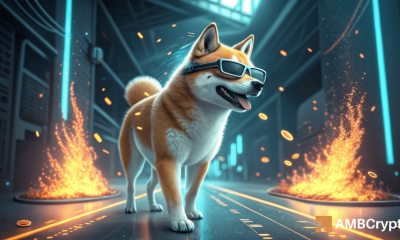
Technology
The rise of user-created video games – Crypto News
“Stop that or someone could get injured!” shouts the teacher, as a pupil stands on her desk, dancing the Macarena. “You are a student, not a baby!” A class of avatars snigger. This is “The Presentation Experience”, a game on Roblox, an app popular with schoolchildren. As one player gives a presentation, others do their best to interrupt and make a nuisance of themselves. By pressing different buttons they can heckle, burp or go to sleep. If they pay they can be even more disruptive: for 99 robux, Roblox’s in-game currency (about $1.25), they can “make everyone mega fart”.
The gameplay is basic and the graphics rudimentary. But “The Presentation Experience” has had 190m plays since it was launched less than 18 months ago. It is one of 32m “experiences” on Roblox, which lets users design and publish homemade games. Never mind that the gameplay looks fairly low-fi; some 60m people play Roblox a day, generating revenue in 2022 of over $2bn in purchases of in-game items—mega farts and all.
The TV business has gone through a revolution in what media types call user-generated content. Smartphones give everyone a way to record and publish home videos in seconds. The result is that even as professional content has become more plentiful and lavishly funded, viewers spend more time on amateur content. Americans under 18 spend almost twice as much time on TikTok and YouTube as on Netflix and Disney+, says Qustodio, which makes parental-control software.
Many wonder if this may happen to gaming. User-made games already have a vast reach among young people. In 2020, amid covid-19 lockdowns, Roblox estimated that three-quarters of American 9- to 12-year-olds were using the platform. “Minecraft”, a Microsoft-owned game that lets players visit each others’ constructions, has 120m monthly players. Like YouTube and TikTok, most user-made stuff is low quality. But like those sites, algorithmic sifting of a near-infinite variety serves up plenty for users.
As on YouTube, ever more content on platforms like Roblox is professionally made. Some small developers have shifted to the platform, aiming for a share of the $600m earned by creators each year. Big brands use it as a place to reach new audiences. Sega has licensed a Sonic game to Roblox. As on YouTube, where creators like Jimmy “MrBeast” Donaldson began as amateurs before turning professional, many successful developers made games as a hobby before going full-time. Simple Games, which makes such Roblox titles as “War Simulator”, began as a hobby for its founder, Nathan Clemens, and now employs his entire family.
View Full Image
The big difference between movies and gaming is that game developers have proved more adept at incorporating user-made content into their productions. Whereas home-made content has emerged as a competitor to professional film-makers, game studios have made it part of their business model, monetising it themselves.
Since the earliest days of PC gaming, players with programming expertise have “modded”, or modified, games by taking the source code and altering it to change the game, sometimes trading their “mods” online, with various degrees of consent from the developer. . Built-in features such as map editors let players make their own designs, and it has become standard to allow players to customize in-game avatars.
do it yourself
The most important user-generated input comes in multiplayer games, where users generate “content” by acting as each other’s opponents. Many recent hits have been online titles like “League of Legends” or “Fortnite”, in which the thrills come from interaction. with other users. “Because players are infinitely creative, you can make the sandbox, throw some people in there, and the player stories that come out of that emergent play are endless,” says Allen Adham of Blizzard Entertainment.
Enlisting players to entertain each other means games stay entertaining for longer. “If you look at the biggest games, there is demand from the players that it’s constantly refreshed…and creating game content is a long process,” says Tom Wijman of Newzoo, a game analyst. “Part of the reason why gaming companies are so eager to stimulate [user-generated content] and incorporate it into their day-to-day business is because it helps them crowdsource this content creation that has become expected by the gaming community”. Mr Adham says “player v player” games “can be very production-efficient, because the players are providing the diversity of play”. Sometimes the creation of new content is well managed. Online fans of games like “Grand Theft Auto” organize together to plan elaborate role-playing scenarios—bank heists, police chases and so on—before playing them. together, often broadcasting the action on video platforms such as Twitch.
The complexity of making a game is a natural brake on how much original content users can generate. Meta’s flagship virtual-reality app, “Horizon Worlds”, has struggled to attract users, partly because it relies on user-made virtual environments that few amateurs are able to build. Yet there is an expectation that artificial intelligence (AI) will make things Much easier. Roblox has shown off a forthcoming feature that will let developers use AI to program games with simple text prompts, such as “make it rain”. Microsoft has reportedly come up with a voice-activated AI assistant for “Minecraft” that builds structures on demand. Niantic, which makes augmented-reality games and apps, has developed a tool to create interactive 3D models using voice instructions. Apple, which may A release of a virtual-reality headset later this year is working on similar technology.
Whether in film or in gaming, demand for user-made content is growing. “This younger generation doesn’t just want content thrown at them,” says Craig Donato, Roblox’s chief business officer. “They want to feel a sense of agency or co-ownership of the medium…[and] that they are not just consumers of content, but that they can also be participants in the creation of the content.” The video-game business has done a better job than Hollywood of turning this to its advantage.
© 2023, The Economist Newspaper Limited. All rights reserved. From The Economist, published under license. The original content can be found on www.economist.com
Catch all the Technology News and Updates on Live Mint. Download Mint News App to get Daily market update Live business news,
Updated: 07 Jun 2023, 03:14 PM IST
-

 Cryptocurrency1 week ago
Cryptocurrency1 week agoThe monetary power of the periphery: How Dallas defends the dollar – Crypto News
-

 Cryptocurrency1 week ago
Cryptocurrency1 week agoNifty 50 Ends Higher After Two-Day Drop, But Bulls Struggle to Break 25,000 – Crypto News
-

 others1 week ago
others1 week agoGold surges above $3,300 as US jobs data disappoints, Trump tariffs blocked – Crypto News
-

 others1 week ago
others1 week agoTrader Michaël van de Poppe Says Ethereum-Based Altcoin Primed To Do Well in Coming Months, Updates Outlook on Bitcoin and Sui – Crypto News
-

 Cryptocurrency1 week ago
Cryptocurrency1 week agoXRP drops 1.05% as resistance levels cap recovery – Crypto News
-
Technology1 week ago
Why Is Pepe Coin Trending Today? – Crypto News
-

 Blockchain1 week ago
Blockchain1 week agoTesting Strength At Key Support – Crypto News
-

 Technology1 week ago
Technology1 week agoCool savings for a hot season: Top 10 deals for you on ACs, refrigerators, microwaves, and more with up to 60% off – Crypto News
-

 Cryptocurrency1 week ago
Cryptocurrency1 week agoOne day left to invest in Bitcoin Pepe before it hits centralised exchanges – Crypto News
-

 Cryptocurrency1 week ago
Cryptocurrency1 week agoSOL Strategies Files $1B Shelf Prospectus to Boost Solana Investment ‘Flexibility’ – Crypto News
-

 Technology1 week ago
Technology1 week agoWhatsApp Status gets new Instagram-like features: Here’s what’s new – Crypto News
-
Cryptocurrency7 days ago
Can Shiba Inu Price Recover as Age Consumed & Falling MVRV Signal Bottom? – Crypto News
-

 Blockchain6 days ago
Blockchain6 days agoCzech Justice Minister Resigns Over $45M Bitcoin Donation Scandal – Crypto News
-

 Blockchain1 week ago
Blockchain1 week agoBitcoin $106,800 Support Retest To Determine BTC’s Next Move – Crypto News
-

 Cryptocurrency1 week ago
Cryptocurrency1 week agoLitecoin price forecast: tracking LTC’s bullish technical setup – Crypto News
-

 Cryptocurrency1 week ago
Cryptocurrency1 week agoLitecoin price forecast: tracking LTC’s bullish technical setup – Crypto News
-

 Cryptocurrency1 week ago
Cryptocurrency1 week agoCold Summer? Bitcoin Price Breaches $105K Support As Tariffs Return to Play – Crypto News
-
Business1 week ago
Sharplink Gaming Files $1 Billion Shelf Offering To Purchase Ethereum – Crypto News
-
others1 week ago
Sharplink Gaming Files $1 Billion Shelf Offering To Purchase Ethereum – Crypto News
-

 Cryptocurrency7 days ago
Cryptocurrency7 days agoBitcoin in ‘make or break’ zone – Trump Media hints at what’s next – Crypto News
-

 Blockchain7 days ago
Blockchain7 days agoBitcoin Still Bullish, But $200,000 Off The Table And $137,000 In Sight – Crypto News
-
Technology6 days ago
Just-In: IMF Raises Red Flag Over Pakistan’s Bitcoin Mining Plans, Is $1.5B IMF Loan at Risk? – Crypto News
-

 Blockchain1 week ago
Blockchain1 week agoRBI Expands Digital Rupee Pilots, UPI Leads Global Real-Time Payments – Crypto News
-

 Blockchain1 week ago
Blockchain1 week agoTelegram raises $1.7 billion via bond offering – Crypto News
-

 Cryptocurrency1 week ago
Cryptocurrency1 week agoXRP futures surge past $223M as price holds $2.27 support – Crypto News
-

 others1 week ago
others1 week agoBankrupt Crypto Exchange FTX Officially Kicks Off Second Round of Creditor Repayments With $5,400,000,000 Distribution – Crypto News
-

 others1 week ago
others1 week agoJPMorgan Chase CEO Warns US Bond Crisis Coming After Massive Money Printing, Says Regulators Will Panic – Crypto News
-

 others5 days ago
others5 days ago‘Nothing Stops This Train’ – Macro Guru Lyn Alden Warns Fed Has No Way To Slow Down Debt Growth in US Financial System – Crypto News
-

 others1 week ago
others1 week agoGold rebounds as US Dollar retreats while court strikes down Trump’s tariffs – Crypto News
-

 Blockchain1 week ago
Blockchain1 week agoEthereum Price Faces Mild Correction — Support Levels in Focus – Crypto News
-
Business1 week ago
XRP Crash: Why Price Is Falling Today? – Crypto News
-
Business1 week ago
Floki Inu Announces Valhalla Mainnet Launch Date; FLOKI Price to Rally? – Crypto News
-

 Metaverse1 week ago
Metaverse1 week agoIndiaAI Mission gets 16,000 new GPUs, three more foundational models – Crypto News
-

 others1 week ago
others1 week ago$413,200,000,000 in Unrealized Losses Hit US Banks As FDIC Warns Rising Rates Adding Pressure – Crypto News
-
Technology1 week ago
What’s Behind the Crypto Price Drop: BTC, ETH, DOGE, XRP Down – Crypto News
-

 Cryptocurrency1 week ago
Cryptocurrency1 week agoFriday Charts: Click here for good news – Crypto News
-

 Blockchain7 days ago
Blockchain7 days agoMajor crypto hacks fell 40% in May, says PeckShield – Crypto News
-
Business6 days ago
Michael Saylor Signals Another Massive Strategy Bitcoin Purchase – Crypto News
-
Business6 days ago
XRP Las Vegas: Brad Garlinghouse Says Bitcoin Is Not The Enemy – Crypto News
-

 Blockchain6 days ago
Blockchain6 days agoStrategy signals another Bitcoin buy on June 2 – Crypto News
-
Cryptocurrency5 days ago
Ethereum’s Pectra Upgrade leaves massive loophole for scammers – Crypto News
-

 Cryptocurrency3 days ago
Cryptocurrency3 days agoShiba Inu burn surges 2,408%: Can SHIB finally escape bearish pressure? – Crypto News
-

 Blockchain1 week ago
Blockchain1 week agoBitcoin Set For 50%+ Move Within 6 Months: Hedge Fund Boss – Crypto News
-
Technology1 week ago
Solana’s Downfall Could Fuel Ethereum Price Rally to $3,500 – Crypto News
-
Business1 week ago
Trump Tariffs Struck Down By US Courts, ‘Buy Everything’ Says Arthur Hayes – Crypto News
-

 Blockchain1 week ago
Blockchain1 week agoCrypto lobby group says SEC should back off regulating most DAOs – Crypto News
-

 others1 week ago
others1 week agoTrader Who Called 2021 Bitcoin and Crypto Collapse Says Key Indicator Now Flashing Green – Crypto News
-

 Blockchain1 week ago
Blockchain1 week agoBitcoin $106,800 Support Retest To Determine BTC’s Next Move – Crypto News
-
Business1 week ago
Is Meta Adopting Bitcoin? What’s behind Strive CEO and Mark Zuckerberg Meeting – Crypto News
-
others1 week ago
Ethereum Price Eyes $3,000 as Whales Accumulate 190,000 ETH – Crypto News














